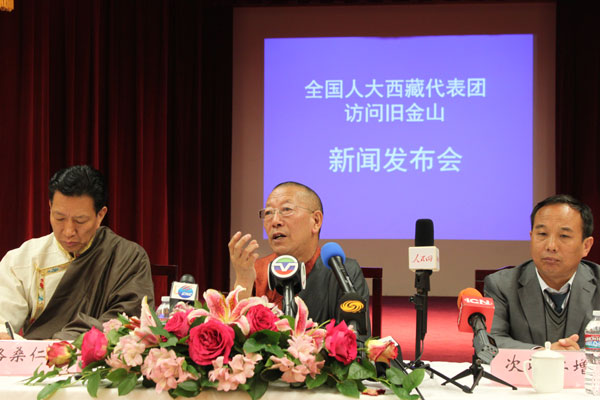 |
|
Shingtsa Tenzinchodrak (center), deputy to China's National People's Congress (NPC), briefs media in San Francisco on Tuesday, accompanied by NPC Tibetan deputies Gesang Renqing (left) and Ciwang Renzeng. Chang Jun / China Daily |
The three-member delegation is headed by Shingtsa Tenzinchodrak, deputy to China's NPC and vice-chairman of the Standing Committee of the People's Congress of Tibet Autonomous Region.
"All the three delegates are natives to Tibet," Tenzinchodrak told reporters at a press conference held Tuesday afternoon at the Chinese Consulate General in San Francisco. "We are willing to share our personal learning and working experience and help the world to know about the real Tibet," said Tenzinchodrak, who is also a living Buddha of the Kagyu sect of the Tibetan Buddhism.
Great changes have taken place in Tibet in the past 60 years with the help of the central government and the Chinese people of other ethnic groups, said Tenzinchodrak, who gave as an example the infrastructure development in the region.
"About 50 years ago, there was no existence of even an inch of highway," he said. "Now we have a road network, though it's not as developed as those in the inland."
There are now five modern airports in Tibet, linking the region with 34 cities in China, he said.
"The development of infrastructure has resulted in a rapid development of tourism in Tibet," he said. "Tourism has now become a pillar industry in the region.
"Many tourists visited Tibet more than once," he said. "They would take their families and friends to Tibet on their second and third trips. Our goal is to build Tibet into a tourist destination for the world, though a lot of work still needs to be done to improve the tourist infrastructure and facilities."
The region's GDP was 90 billion yuan (about $14.5 billion) in 2014, compared with 130 million in 1951, said Tenzinchodrak, quoting government statistics.
Tibetans also have benefited from expanded health care, education and cultural offerings, according to the delegation.
A Tibetan's life expectancy has reached 68, while the figure was only 35.5 some 60 years ago, Tenzinchodrak said.
"Before Tibet was liberated in 1959, there was no school in a modern sense, and the illiteracy rate was as high as 95 percent," he said. "Now, Tibet has a complete educational system, and the enrollment rate for children of school age has reached 99 percent."
Tenzinchodrak also said that religious freedom was fully protected in the region.
"Tibet now has more than 1,700 religious sites and about 46,000 monks and nuns," he said. "There are also some mosques and a Catholic church," he added.
Tenzinchodrak also stressed that the Tibetan people are firmly opposed to any secessionist attempt.
"Most of them (the secessionists) were born and brought up overseas, so they do not know what Tibet is like now," he said. "If they could come over and have a look for themselves, I believe their mindset would be changed."
liazhu@chinadailyusa.com